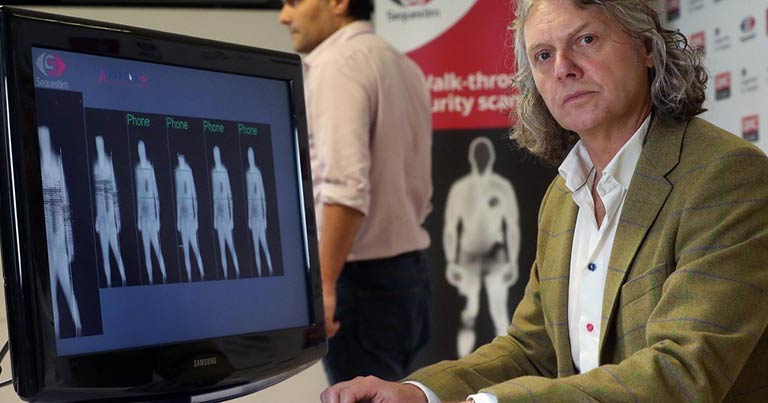
A super-sensitive passenger scanner that reveals hidden security threats is being trialled at Cardiff Airport in the UK. The walk-through scanner, which uses space technology to image human body heat, is the result of a collaboration between Sequestim Ltd. and Cardiff University scientists.
Computer learning allows the scanner to distinguish between threats and non-threats but without the need for passengers to keep still or remove outer clothing. The technology has the potential to reduce queues at airport terminals as it screens people on the move.
“Passenger numbers are expected to double in 20 years, putting airport security facilities under immense pressure,” said Ken Wood, Sales and Marketing Director of Sequestim Ltd, a joint venture between Cardiff University and QMC Instruments Ltd. “Our scanner combines a number of world-leading technologies developed by our team here in the UK. It uses the human body as a source of “light”, in contrast with existing scanners which process reflected and scattered millimetre-waves while the passenger is required to strike a pose.”
“Our system only needs a few seconds to do its work. Passengers walking normally through security would no longer need to take off coats and jackets, or remove personal items such as phones.”
The trial at Cardiff Airport has been taking place privately, by invitation only, from 4 to 7 December. It aims to prove that passive terahertz imaging is robust, versatile, fast and convenient. The project is one of eight to receive some of the £1.8m funding made available by the UK Government earlier this year through a Defence and Security Accelerator themed competition. Part of the five-year Future Aviation Security Solutions (FASS) programme, the multimillion-pound initiative seeks innovative ideas such as this new passenger scanner to help strengthen aviation security.
Originally built to study the furthest reaches of the universe, the technology used is so sensitive it could see a 100W light bulb at a distance of 500,000 miles (twice the distance to the Moon.) The scanner quickly “learns” the difference between items that can and cannot be taken onto an aircraft, reducing the risk of false alarms.
“The detector technology was originally developed to study the most distant astronomical phenomena. For example, we study how stars are born from gigantic clouds of gas and dust,” explained Wood. “It detects millimetre-waves, which are just like visible light but at a wavelength more than one thousand times longer. The ability of the scanner to reveal hidden objects has also attracted interest from Border Force, responsible for the UK’s frontline border control operations at air, sea and rail ports.
“Any concealed items show up very clearly as a shadow because the human body, by dint of its heat, acts like a light bulb for our scanner. The new scanner images do not present any ethical issues because anatomical details do not show up. No-one will need to see the images when the technology is eventually used for real, however, because the system will be completely automatic.”
UK Aviation Minister Liz Sugg said: “We have a proud history of innovation here in the UK and passenger safety across all modes of transport remains an important priority for the government. The Future Aviation Security Solutions programme demonstrates our support for pioneering projects that can help to reduce security threats in airports. I am pleased to see that the funding awarded to Sequestim has helped the team take space technology and trial it as part of a new passenger screening system at Cardiff Airport.”
The purpose of the trial is for key members of industry, the Centre for the Protection of National Infrastructure, the Civil Aviation Authority and other government bodies including Border Force, to see the technology in action.






